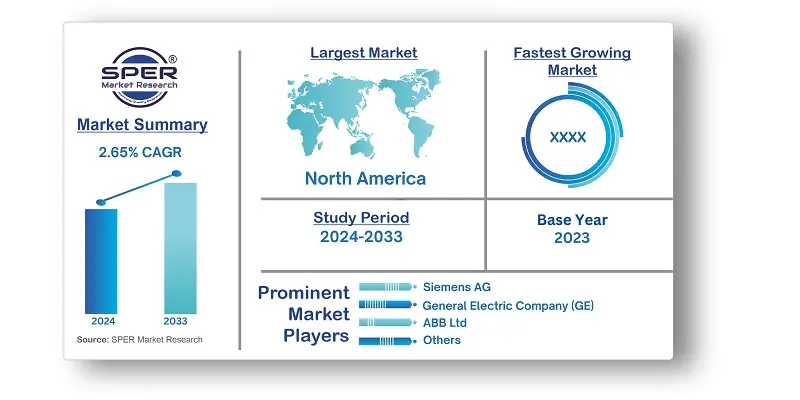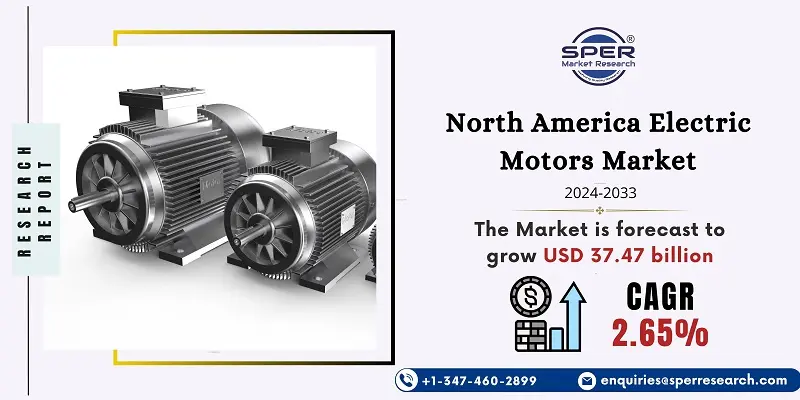
North America Electric Motors Market Trends, Share, Size, Demand, Revenue and Future Outlook
North America Electric Motors Market Growth, Size, Trends Analysis- By Motor Type, By Voltage Type, By Application- Regional Outlook, Competitive Strategies and Segment Forecast to 2033
| Published: Oct-2024 | Report ID: POAE2487 | Pages: 1 - 159 | Formats*: |
| Category : Power & Energy | |||
- May 2022 - An electric motor (e-motor) for the Lilium Jet was co-developed by globally recognised aerospace company Honeywell and mobility provider DENSO Corporation. This device represents DENSO's first foray into the aerospace industry and is the first product that Honeywell and DENSO have developed together since formally forming their alliance.
- The acquisition of Bison Gear & Engineering Corp. (Bison), a top producer of highly designed motion control solutions covering a variety of markets and applications, was announced by AMETEK, Inc. in May 2023. For use in difficult and precise applications in the automation, power, food & beverage, and transportation sectors, Bison develops and produces specialised motion control solutions.


| Report Metric | Details |
| Market size available for years | 2020-2033 |
| Base year considered | 2023 |
| Forecast period | 2024-2033 |
| Segments covered | By Motor Type, By Voltage Type, By Application. |
| Regions covered | Canada, Mexico United States, Cuba, Panama, Greenland, Rest of North America. |
| Companies Covered | Robert Bosch GmbH, General Electric Company, ABB Ltd, Mitsubishi Heavy Industries Ltd, Siemens AG, Hitachi, Ltd, Emerson Electric Co, Denso Corporation, Toshibha Corporation, Brook Corporation. |
- Electric Motor Manufacturers
- Automotive Manufacturers
- Industrial Machinery Manufacturers
- HVAC System Manufacturers
- Aerospace and Defense Companies
- Electric Vehicle (EV) Manufacturers
- Renewable Energy Companies
- Construction Equipment Manufacturers
- Government Regulatory Bodies
- Electrical Distributors and Suppliers
- Research and Development Institutions
- Industrial Automation Companies
- Marine Equipment Manufacturers
| By Motor Type: | |
| By Voltage Type: | |
| By Application: |
- North America Electric Motors Market Size (FY’2024-FY’2033)
- Overview of North America Electric Motors Market
- Segmentation of North America Electric Motors Market by Motor Type (DC and AC)
- Segmentation of North America Electric Motors Market by Voltage Type (Less Than 1 KV, Between 1 KV - 6 KV, and Higher Than 6 KV)
- Segmentation of North America Electric Motors Market by Application (Residential, Commercial, Industrial, and Automotive)
- Statistical Snap of North America Electric Motors Market
- Expansion Analysis of North America Electric Motors Market
- Problems and Obstacles in North America Electric Motors Market
- Competitive Landscape in the North America Electric Motors Market
- Impact of COVID-19 and Demonetization on North America Electric Motors Market
- Details on Current Investment in North America Electric Motors Market
- Competitive Analysis of North America Electric Motors Market
- Prominent Players in the North America Electric Motors Market
- SWOT Analysis of North America Electric Motors Market
- North America Electric Motors Market Future Outlook and Projections (FY’2024-FY’2033)
- Recommendations from Analyst
1.1. Scope of the report1.2. Market segment analysis
2.1. Research data source
2.1.1. Secondary Data2.1.2. Primary Data2.1.3. SPER’s internal database2.1.4. Premium insight from KOL’s
2.2. Market size estimation
2.2.1. Top-down and Bottom-up approach
2.3. Data triangulation
4.1. Driver, Restraint, Opportunity and Challenges analysis
4.1.1. Drivers4.1.2. Restraints4.1.3. Opportunities4.1.4. Challenges
4.2. COVID-19 Impacts of the North America Electric Motors Market.
5.1. SWOT Analysis
5.1.1. Strengths5.1.2. Weaknesses5.1.3. Opportunities5.1.4. Threats
5.2. PESTEL Analysis
5.2.1. Political Landscape5.2.2. Economic Landscape5.2.3. Social Landscape5.2.4. Technological Landscape5.2.5. Environmental Landscape5.2.6. Legal Landscape
5.3. PORTER’s Five Forces
5.3.1. Bargaining power of suppliers5.3.2. Bargaining power of buyers5.3.3. Threat of Substitute5.3.4. Threat of new entrant5.3.5. Competitive rivalry
5.4. Heat Map Analysis
6.1. North America Electric Motors Market Manufacturing Base Distribution, Sales Area, Product Type6.2. Mergers & Acquisitions, Partnerships, Product Launch, and Collaboration in North America Electric Motors Market
7.1. North America Electric Motors Market Size, Share and Forecast, By Motor Type, 2020-20267.2. North America Electric Motors Market Size, Share and Forecast, By Motor Type, 2027-20337.3. DC Motor7.4. AC Motor
8.1. North America Electric Motors Market Size, Share and Forecast, By Voltage Type, 2020-20268.2. North America Electric Motors Market Size, Share and Forecast, By Voltage Type, 2027-20338.3. Less Than 1 KV8.4. Between 1 KV - 6 KV8.5. Higher Than 6 KV
9.1. North America Electric Motors Market Size, Share and Forecast, By Application, 2020-20269.2. North America Electric Motors Market Size, Share and Forecast, By Application, 2027-20339.3. Residential9.4. Commercial9.5. Industrial9.6. Automotive
10.1. North America Electric Motors Market Size and Market Share
11.1. North America Electric Motors Market Size and Market Share By Region (2020-2026)11.2. North America Electric Motors Market Size and Market Share By Region (2027-2033)11.3. North America
11.3.1. Canada11.3.2. Mexico11.3.3. United States11.3.4. Cuba11.3.5. Panama11.3.6. Greenland11.3.7. Rest of North America
12.1. Robert Bosch GmbH
12.1.1. Company details12.1.2. Financial outlook12.1.3. Product summary12.1.4. Recent developments
12.2. General Electric Company
12.2.1. Company details12.2.2. Financial outlook12.2.3. Product summary12.2.4. Recent developments
12.3. ABB Ltd
12.3.1. Company details12.3.2. Financial outlook12.3.3. Product summary12.3.4. Recent developments
12.4. Mitsubishi Heavy Industries Ltd
12.4.1. Company details12.4.2. Financial outlook12.4.3. Product summary12.4.4. Recent developments
12.5. Siemens AG
12.5.1. Company details12.5.2. Financial outlook12.5.3. Product summary12.5.4. Recent developments
12.6. Hitachi, Ltd
12.6.1. Company details12.6.2. Financial outlook12.6.3. Product summary12.6.4. Recent developments
12.7. Emerson Electric Co
12.7.1. Company details12.7.2. Financial outlook12.7.3. Product summary12.7.4. Recent developments
12.8. Denso Corporation
12.8.1. Company details12.8.2. Financial outlook12.8.3. Product summary12.8.4. Recent developments
12.9. Toshibha Corporation
12.9.1. Company details12.9.2. Financial outlook12.9.3. Product summary12.9.4. Recent developments
12.10. Brook Corporation
12.10.1. Company details12.10.2. Financial outlook12.10.3. Product summary12.10.4. Recent developments
12.11. Others
SPER Market Research’s methodology uses great emphasis on primary research to ensure that the market intelligence insights are up to date, reliable and accurate. Primary interviews are done with players involved in each phase of a supply chain to analyze the market forecasting. The secondary research method is used to help you fully understand how the future markets and the spending patterns look likes.
The report is based on in-depth qualitative and quantitative analysis of the Product Market. The quantitative analysis involves the application of various projection and sampling techniques. The qualitative analysis involves primary interviews, surveys, and vendor briefings. The data gathered as a result of these processes are validated through experts opinion. Our research methodology entails an ideal mixture of primary and secondary initiatives.



Frequently Asked Questions About This Report
PLACE AN ORDER
Year End Discount
Sample Report
Pre-Purchase Inquiry
NEED CUSTOMIZATION?
Request CustomizationCALL OR EMAIL US
100% Secure Payment






Related Reports
Our Global Clients
Our data-driven insights have influenced the strategy of 200+ reputed companies across the globe.




















